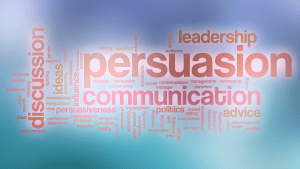Persuasive techniques are essential tools in communication that can help us convince others to adopt our ideas or take specific actions. These techniques have been used throughout history by politicians, marketers, and everyday people to shape opinions and influence decisions. The power of persuasion lies in its ability to change minds, motivate action, and make a lasting impact on others.
In today’s interconnected world, persuasive techniques are more important than ever. Our daily lives are filled with messages and information, all vying for our attention and looking to persuade us in one way or another. From advertising and political campaigns to social media influencers and even our friends and family, the art of persuasion is everywhere.
In this article, we will explore the fascinating world of persuasive techniques, delving into the significance of persuasion in everyday life, the ancient art of rhetoric, and the three main persuasive methods: Logos, Ethos, and Pathos. We will also provide real-life examples and tips on how to enhance your persuasion skills and make a lasting impact on those around you.
The Significance of Persuasion in Everyday Life
Persuasion is an essential skill that plays a significant role in our everyday lives. Whether we are trying to convince a friend to join us on a trip, pitch a new idea at work, or persuade a potential client to choose our product or service, the power of persuasion can make all the difference. By mastering persuasive techniques, we can improve our communication skills, build stronger relationships, and ultimately achieve our goals and aspirations.
In the world of business, persuasion is a vital skill that can lead to success in marketing, sales, and customer service. Marketers use persuasive techniques to create compelling advertisements that resonate with their target audience, while salespeople rely on their persuasion abilities to close deals and ensure customer satisfaction. Moreover, strong persuasive skills can also aid in negotiation, conflict resolution, and team building.
Furthermore, persuasion techniques are invaluable in our personal lives, from maintaining healthy relationships with friends and family to advocating for ourselves and our beliefs. By understanding and implementing effective persuasion methods, we can better navigate the complexities of interpersonal communication and make a lasting impact on others.
The Art of Rhetoric: Logos, Ethos, and Pathos
The foundation of persuasive techniques can be traced back to ancient Greece and the work of the philosopher Aristotle. In his treatise,Rhetoric, Aristotle introduced three primary methods of persuasion that remain relevant to this day: Logos, Ethos, and Pathos. These three rhetorical appeals form the basis of effective persuasion and can be used individually or in combination to create a compelling argument.
Logos: Mastering the Art of Logical Persuasion
Logos, derived from the Greek word for “reason,” refers to the logical appeal of an argument. This form of persuasion relies on presenting clear, rational, and well-organized evidence to support a particular claim. By using facts, statistics, and logical reasoning, the persuader aims to demonstrate the validity of their argument and convince their audience through the sheer force of reason.
To master the art of logical persuasion, it is essential to conduct thorough research and gather strong evidence to support your claims. Presenting accurate, verifiable information is crucial to establishing a solid foundation for your argument. Additionally, it’s important to structure your argument in a clear, coherent manner, using logical transitions that allow your audience to follow your line of reasoning.
However, it’s essential to remember that relying solely on logos may not always be enough to persuade your audience. While a logical argument can be persuasive in its own right, it’s important to consider the emotional and ethical elements of your message, as these can significantly enhance your overall persuasive power.
Ethos: Establishing Credibility and Trust
Ethos, derived from the Greek word for “character,” refers to the ethical appeal of an argument. This form of persuasion relies on the speaker’s credibility, reputation, and trustworthiness to convince the audience of their argument’s validity. To establish ethos, the persuader must demonstrate their expertise, integrity, and goodwill towards their audience.
Establishing credibility and trust is crucial to effective persuasion. Your audience is more likely to be persuaded by someone they perceive as knowledgeable, reliable, and genuinely concerned for their well-being. To build ethos, consider highlighting your relevant qualifications, experiences, or accomplishments that demonstrate your expertise in the subject matter. Additionally, it’s important to maintain an honest, respectful tone and avoid manipulative tactics that could undermine your credibility.
It’s important to note that ethos is not solely about the persuader’s personal attributes. The sources of information and evidence you use in your argument can also contribute to your overall credibility. Citing reputable sources and providing accurate, up-to-date information can help further establish your argument’s validity and enhance your ethos.
Pathos: Tapping into Emotions for Persuasive Power
Pathos, derived from the Greek word for “suffering” or “experience,” refers to the emotional appeal of an argument. This form of persuasion aims to evoke specific emotions in the audience to make them more receptive to the persuader’s message. By tapping into emotions such as fear, anger, joy, or empathy, the persuader can create a strong emotional connection with their audience and increase their persuasive power.
To effectively use pathos in your persuasive efforts, it’s essential to understand your audience’s values, beliefs, and concerns. This understanding will allow you to craft an emotionally resonant message that speaks directly to your audience’s feelings and experiences. Utilizing vivid language, storytelling, and powerful imagery can help evoke the desired emotions and create a lasting impact on your audience.
However, it’s crucial not to over-rely on emotional appeals or resort to manipulation. While pathos can be an incredibly powerful persuasive tool, it’s important to balance emotional appeals with logical and ethical considerations to create a well-rounded and convincing argument.
Balancing the Use of Logos, Ethos, and Pathos
While each of the three persuasive techniques – Logos, Ethos, and Pathos – can be effective on their own, the most compelling arguments often involve a careful balance of all three. By combining logical, ethical, and emotional appeals, you can create a persuasive message that caters to the diverse needs and preferences of your audience.
When crafting your persuasive message, consider how the different elements of Logos, Ethos, and Pathos can complement and reinforce one another. For example, a strong logical argument (Logos) backed by credible sources (Ethos) and presented in an emotionally compelling way (Pathos) can significantly enhance your overall persuasive power. Additionally, it’s important to adapt your balance of Logos, Ethos, and Pathos to suit your specific audience and context, as different situations may call for different persuasive approaches.
By developing a comprehensive understanding of these three persuasive techniques and learning to balance them effectively, you can significantly improve your communication skills and increase your chances of achieving your persuasive goals.
Persuasive Techniques in Action: Real-life Examples
To illustrate the power of persuasive techniques, let’s look at some real-life examples that showcase the effective use of Logos, Ethos, and Pathos.
Example 1: Martin Luther King Jr.’s “I Have a Dream” Speech
In his famous “I Have a Dream” speech, Martin Luther King Jr. masterfully combined all three rhetorical appeals to create a powerful and persuasive call for racial equality. Through the use of Logos, King presented a well-reasoned argument for civil rights, referencing the US Constitution and the Declaration of Independence. His Ethos was evident in his status as a prominent civil rights leader and his commitment to nonviolent protest. Finally, King’s use of Pathos – including vivid imagery, emotive language, and his evocative “I Have a Dream” refrain – created a powerful emotional connection with his audience and left a lasting impact on American society.
Example 2: Apple’s “Think Different” Campaign
Apple’s iconic “Think Different” advertising campaign is another excellent example of persuasive techniques in action. The campaign, which featured images of influential figures such as Albert Einstein, Mahatma Gandhi, and Amelia Earhart, relied heavily on Ethos to establish Apple as a trailblazing, innovative company. The use of Pathos was evident in the campaign’s emotive tagline, “Here’s to the crazy ones,” which evoked a sense of inspiration and aspiration among Apple’s target audience. Finally, while Logos was not the primary focus of the campaign, Apple’s reputation for cutting-edge technology and design provided a solid foundation for their persuasive message.
Enhancing Your Persuasion Skills: Tips and Resources
Now that we’ve explored the foundations of persuasive techniques, let’s look at some tips and resources to help you enhance your persuasion skills and make a lasting impact on your audience.
- Know your audience: Understanding your audience’s demographics, values, and concerns is crucial to crafting a persuasive message that resonates with them. Take the time to research and analyze your audience before developing your argument.
- Be clear and concise: A clear, well-organized argument is much more persuasive than a convoluted or poorly structured one. Ensure your message is easy to understand and follow by using simple language, logical transitions, and a coherent structure.
- Practice empathy: Putting yourself in your audience’s shoes can help you better understand their perspective and craft a more persuasive message. Try to see things from their point of view and address any potential objections or concerns they may have.
- Use storytelling: Stories are a powerful tool for creating an emotional connection with your audience and making your message more memorable. Incorporate personal anecdotes, relevant examples, or hypothetical scenarios to bring your argument to life.
- Be confident: Confidence is key to effective persuasion. Believe in your message and your ability to persuade others, and your audience will be more likely to be convinced.
Some useful resources to further develop your persuasive skills include:
- Books such asInfluence: The Psychology of Persuasion by Robert Cialdini,How to Win Friends and Influence People by Dale Carnegie, andThe Art of Persuasion: How to Influence People and Get What You Want by Juliet Erickson.
- Online courses, webinars, and workshops on persuasion, communication, and public speaking.
- TED Talks and other public speaking events, which can provide valuable examples of persuasive techniques in action.
Conclusion: The Power of Persuasion in Personal and Professional Life
In conclusion, mastering persuasive techniques is essential for success in both our personal and professional lives. By understanding the principles of Logos, Ethos, and Pathos, as well as learning to balance these elements effectively, we can significantly improve our communication skills and increase our chances of achieving our goals.
By practicing and refining our persuasive abilities, we can make a lasting impact on others, inspire positive change, and ultimately lead more fulfilling, successful lives. So, take the time to explore the fascinating world of persuasive techniques and unlock the secrets of Logos, Ethos, and Pathos – your future self will thank you.
Resources
- Aristotle. (1991).On Rhetoric: A Theory of Civic Discourse (G. A. Kennedy, Trans.). Oxford University Press.
- Cialdini, R. B. (1984).Influence: The Psychology of Persuasion. HarperCollins.
- Carnegie, D. (1936).How to Win Friends and Influence People. Simon & Schuster.
- Erickson, J. (2019).The Art of Persuasion: How to Influence People and Get What You Want. DK.
- Harvard Business Review. (n.d.).Persuasion. Retrieved from https://hbr.org/topic/persuasion
- TED Talks. (n.d.).Persuasion. Retrieved from https://www.ted.com/topics/persuasion
- Skillshare. (n.d.).Persuasion. Retrieved from https://www.skillshare.com/browse/persuasion
- Coursera. (n.d.).Communication. Retrieved from https://www.coursera.org/courses?query=communication
- Udemy. (n.d.).Public Speaking. Retrieved from https://www.udemy.com/topic/public-speaking/
Remember, persuading others is not about manipulation or coercion, but rather about presenting your ideas in a clear, compelling, and respectful manner. By following the principles of Logos, Ethos, and Pathos, as well as practicing empathy, storytelling, and confidence, you can become a master of persuasion and achieve your goals with ease.










